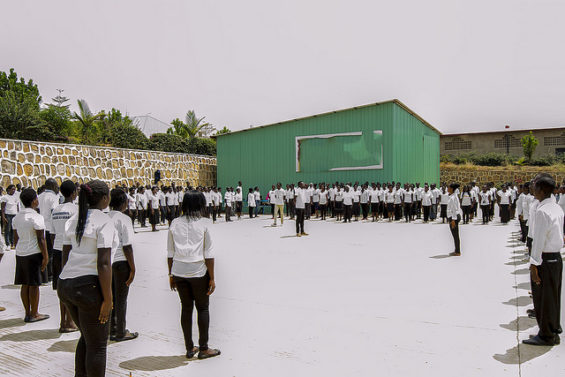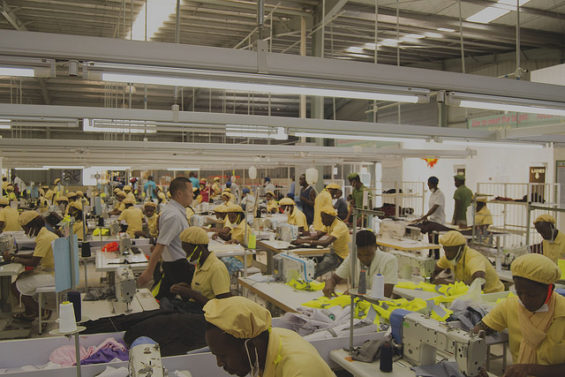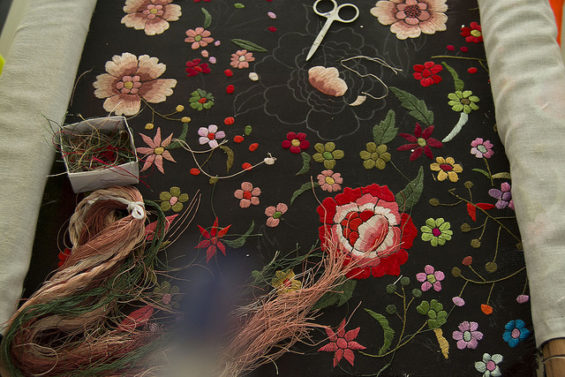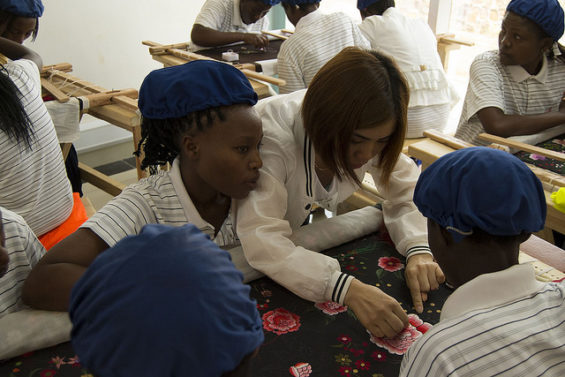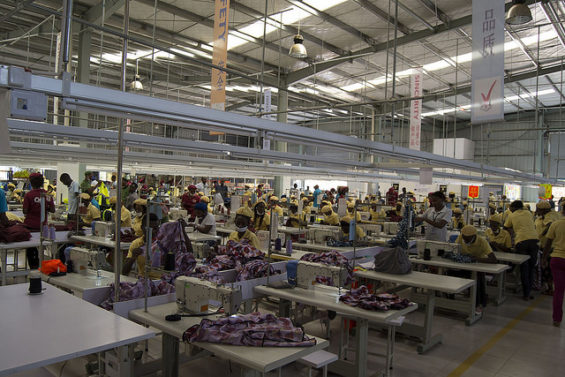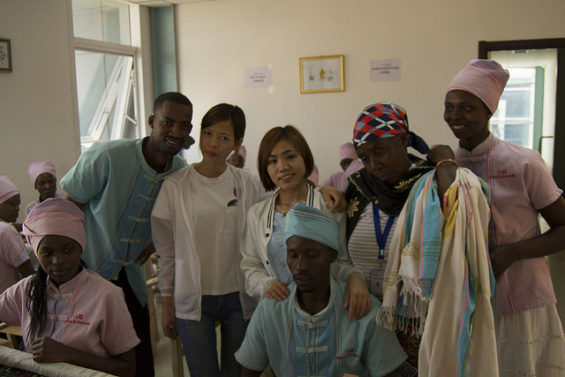…as Chinese Garment Manufacturer Transfers Production Skills to East Africa.
Posted on August 19, 2016
In the outskirts of Rwanda’s capital city in a zone designated as Kigali Special Economic Zone, more than 200 young women and men are lined up in a drill command.
A passerby might think that it is an instruction to a military parade as close-order maneuvering restricts their movement followed by shouts.
The aim of the daily morning exercise is, however, intended to instill discipline among factory workers. Additionally managers use this platform to make announcements to the entire workforce.
Before they get a job new recruits also go through this exercise, which lasts three weeks as a prerequisite to join a six-month training period. During this time, new recruits are trained to master the drill command as well as learn the company rules and regulations.
“As new recruits they don’t know what is going on inside the factory, trainers use this opportunity to introduce them to C&H Garments LTD Rwanda”, says Ange Akinkamiye the company human resources assistant.
Ms. Akinkamiye argues that some companies in China have the same system and that it is intended to shape the workforce’s discipline as new recruits come from different backgrounds.
“Some are orphans, high school graduates and retired military (among others) so we have to bring them together and teach them discipline that conforms to the C&H organizational culture”, adds the human resources assistant.
Didier Mazimpaka is a fresh high school graduate and is among the new recruits who are going through three weeks of drill command.
“We are learning the responsibility of the new job to work hard and together with our colleagues before we embark on a six-month training period whereby we are expected to acquire skills to make garments”, says the 20-year-old.
The new recruits are divided in two groups whereby the majority goes to learn sewing machines and the rest will go to the handmade department.
In the factory second floor a group of 48 trainees has been undergoing embroidery training for the last three months with two Chinese trainers.
Initial communication problems
The latter are confronted by communication problems with their students and have to use signs, which is not easy.
Fortunately the embroidery department manager, Ms. Sandra Dushimiyimana, is there to ease the problem.
The Chinese government sponsored her high school and she got a scholarship to go to China for one year and learn the language.
“I am helping with translation as in this department Chinese trainers cannot speak English. Sometimes I am working as a manager, sometimes as a translator”, the embroidery department manager points out smilingly.
Ms. Dushimiyimana is required to move in the factory’s different departments to help with communication problems between trainers and trainees.
She is nevertheless happy with the fact that young men are mastering embroidery just like their female counterparts, something Chinese trainers were not expecting at the beginning of the training.
New skills
Trainees started to learn a Rwandan embroidery style with a local trainer before the Chinese trainers introduced them to Guanzhong style of embroidery.
“We are learning hand-making embroidery and after this training I will be among few people in Rwanda who knows this technique”, notes Freddy Mukotanyi.
Trainer Tan Chuanying says that in China they have five different types of embroidery but that she is teaching her students the Guanzhong style.
Though she enjoys the whole experience, Tan acknowledges the communication challenge with her trainees. “The first challenge we found when we started teaching is the language because we didn’t know English”.
In he beginning of the training Tan wanted to show trainees a new technique but they could not understand. But with time the communication improved with the adoption of common signs and the help of a translator.
The factory human resources manager Mr. Hitimana Saidi points out that the handmade department is strategic as Rwanda plans to become a center of creative arts.
“You know Chinese people are experts in the handmade arts and crafts so they are training our workforce how to make nice handmade garments so that we can get more markets in the USA and Europe”.
However the sewing department is the largest with more than 500 workers busy making garments with sewing machines under the supervision of Chinese and Kenyan technicians.
In less than two years James Rwikiriza has risen in the company’s rank to become the manager of the finishing and packing department. He recognizes that to work in this factory comes with many benefits in addition to the monthly salary that averages $100.
“The first opportunity in this factory is knowledge as we learnt to use electrical sewing machines that we don’t have in Rwanda in addition to interacting with Chinese and Kenyans technicians”, says Mr. Rwikiriza.
The majority of factory workers come here without any previous knowledge in the garments making business. They are taught to stitch garments, measure every piece, and create clothing patterns, among other techniques.
The government of Rwanda is constantly attracting these kinds of investors through various schemes.
Given the facilities such as the availability of industrial and commercial lands and the low cost of energy managed by the Special Economic Zones Authority (SEZAR), it makes sense for the Chinese garments manufacturer to invest in Rwanda.
Setting up in Rwanda
It is in this regard that in July 2014, C&H Garments LTD Rwanda owners Helen Hai and Candy Ma came to Rwanda.
They signed a Memorandum of Understanding (MoU) with the Rwanda Development Board, a government institution in charge of fast tracking economic development by enabling private sector growth.
The MoU stated that the Chinese garments manufacturer was expected to invest $2 million’s worth of equipment in a Rwanda training base and employ at least 200 workers.
The end result was to spur the process of creating a Rwandan garments manufacturing sector that would later have a significant impact on job creation and exports for Rwanda.
Consolidation
Two years down the road, the Chinese garments manufacturer is slowly consolidating its base in Rwanda after its success in Ethiopia where the owners set up one of the biggest shoe manufacturer in Sub-Saharan Africa.
C&H Garments LTD Rwanda started its operations in 2015 and is now employing 800 factory workers.
The company trains new recruits for a period of six months with the help of Rwanda Development Board (RDB) and Workforce Development Authority (WDA) after that they get employment contract.
The factory manager Anna An said that the factory empowers youth with technical skills.
“We teach them how to use the machines and then later if they acquire enough skills we employ them or they can go out and maybe open their own small factories.”
She further said that in three to five years the company would be employing 3,000 to 5,000 factory workers. Already by the end of the year the factory will be employing 1,500 factory workers and has so far exported eight to ten containers to USA, Europe, China and South Africa.
The factory makes different styles of garments like shirts, T-shirts, trousers, jackets, depending on orders from its customers.
Challenges and future prospects
“In our factory we work by line. We have five lines and each line can respectively make 3,000 T-shirts, 1,000 shirts, 500 trousers and 400 hundred jackets per day”, says Saidi Hitimana, the factory’s human resources manager.
Nevertheless the company has to deal with transport challenges that increase the costs of doing business because Rwanda is a landlocked country.
Mr. Hitimana notes that the company imports raw materials from China, Kenya, Tanzania and Ghana, and then exports the finished product to the USA, Europe, South Africa and (a little) to China.
Still the future is bright as the factory’s workforce is expected to reach 5,000 workers in the next five years given the recent government policy to gradually ban imported used clothes and give more room to locally made garments.
While presenting the National Budget in Parliament in June this year, Claver Gatete, the minister of finance and economic planning, announced a respective tax increase of 12% and 15% for imported used clothes and shoes.
The minister argued that the move is aimed at supporting locally made products and industries. He further stated that the new policy would help create more jobs and prevent health risks that are associated with used products.
The decision to ban imported used clothes and shoes was also taken in February by the East African Community. The new policy is aimed at encouraging local production and the development of member states Burundi, Kenya, Rwanda, Tanzania and Uganda.
One of the beneficiaries of this policy is C&H Garments LTD Rwanda. The factory’s original plan was to export 100% of its production, but the government has licensed the factory to export 80% and sell the remaining 20% in the local market.
“We plan to build a new factory that will employ 5,000 workers whereby 3,000 and 2,000 workers will respectively be making garments for export and local markets”, says Mr. Hitimana.
Given the Rwandan market of more than 12 million people, it will take time before the C&H Garments factory reaches the capacity to manufacture clothes that effectively supply the whole market.
In the meantime more young people are expected to join the local garments manufacturing industry as the new government policy is expected to attract more players into the virgin industry.
This article was produced with a reporting grant provided by the China-Africa Reporting Project by Rwandan journalist Daniel Nzohabonimana. He also produced the video below and a series of photographs that can be viewed on Flickr. Source: China-Africa Reporting Project.

